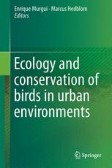Search
Search Results
-
City Lifestyles: Behavioral Ecology of Urban Raptors
If there is a single unifying characteristic of urban/suburban wildlife species, it is likely adaptability. Species that can occupy urban areas are...
-
Urban Raptor Communities: Why Some Raptors and Not Others Occupy Urban Environments
We live in a world that is experiencing rapid landscape-level changes due to human activities. Indeed, the argument can be made that, from a wildlife...
-
Management and Conservation of Urban Raptors
As many chapters in this book have discussed, whether increased urbanization has overall benefits for raptors is not yet clear. In fact, the...
-
Costs and Benefits of Urban Living in Raptors
Increasing human populations have accelerated urbanization and altered natural habitats. This process began in the eighteenth century with the...
-
Raptor Mortality in Urban Landscapes
During the normal course of their lives in exurban landscapes, raptors are killed by weather, accidents, disease, predators, and each other. For...
-
Haemosporidian infection of the American Kestrel in the southern Chihuahua Desert, Mexico: relationship with land use
We aimed to assess haemosporidian prevalence and parasitaemia in the American Kestrel ( Falco sparverius ) in relation to land use (i.e. small villages...

-
The breeding performance of raptors in urban landscapes: a review and meta-analysis
Global urbanisation is rapidly increasing and can have profound impacts on wild flora and fauna. For many species, the impacts are detrimental and...

-
Urbanization and Raptors: Trends and Research Approaches
Urbanization presents a major global issue for the conservation and survival of many different species. With the increasing footprint of cities and...
-
Perspectives and Future Directions
Urbanization is both a landscape process and a demographic process. Most people are familiar with the changes on the landscape that have occurred on...
-
Demography of Raptor Populations in Urban Environments
Lands modified by humans vary widely in their environmental features, from areas that retain much of their natural character to areas in the urban...
-
Harris’s Hawks: All in the Family
From Phoenix, Arizona, south to Buenos Aires, Argentina, residents of many cities have Harris’s hawks (Parabuteo unicinctus) as neighbors. This...
-
Raptors and People: An Ancient Relationship Persisting Today
Symbolic or religious value has been attributed to raptor feathers in many cultures. This behavior seems to be rooted in ancient times; bones and...
-
Urban Raptor Case Studies: Lessons from Texas
The presence of raptors in cities brings up many questions for wildlife managers and agencies and raises some fundamental questions about how to...
-
How do birds look at their world? A novel avian visual fixation strategy
AbstractA central assumption in behavioral research is that the observer knows where an animal is looking; however, establishing when an animal is...

-
Raptors as Victims and Ambassadors: Raptor Rehabilitation, Education, and Outreach
From hunting songbirds at backyard feeders to circling in awe-inspiring loops above a city park, raptors make their presence known in urban...
-
A test of the eavesdrop** avoidance hypothesis as an explanation for the structure of low-amplitude aggressive signals in the song sparrow
AbstractLow-amplitude signals function in private exchanges of information between signalers and nearby receivers. The eavesdrop** avoidance...

-
Conservation Genetics in Raptors
Biodiversity is being depleted worldwide at unprecedented rates, due to direct or indirect human actions. These biodiversity losses affect all three...
-
Avian phenotypic traits related to feeding preferences in two Culex mosquitoes
Host choice by mosquitoes affects the transmission dynamics of vector-borne infectious diseases. Although asymmetries in mosquito attraction to...

-
Spatial distribution and the value of green spaces for urban red-tailed hawks
Raptors increasingly live and nest successfully in urban areas. In the urban landscape of Hartford, CT, red-tailed hawks established home ranges in...

-
The Role of Landscape-Scale Factors in Sha** Urban Bird Communities
The composition of urban bird communities is clearly affected by local habitat factors. These factors often determine whether individuals choose to...
